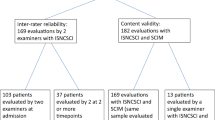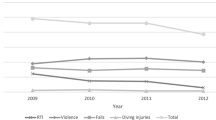Abstract
Study design
Multicentric psychometric study.
Objectives
The aim of this study is to introduce the development of the Sitting Balance Assessment for Spinal Cord Injury (SitBASCI) and assess its inter-rater reliability and internal consistency.
Setting
The study was developed among the three Spinal Units of San Bortolo Hospital in Vicenza, Niguarda Hospital in Milan and AOU Careggi in Florence.
Methods
SitBASCI is a 13-item scale developed to evaluate trunk control in individuals with SCI. Subjects were filmed while performing the 13 items of the scale. The videotapes were submitted to 25 examiners who evaluated patients’ performances with the scale. The power of the study was estimated. The interclass correlational coefficient (ICC) was used to assess the inter–rater reliability of the examiner’s evaluations regarding each item and the total. Cronbach’s alpha was used to assess internal consistency of the scale and internal consistency of the scale on the eliminated item.
Results
The study showed to have a significant power. The inter-rater reliability for the total score was ptot = 0.997 (item’s values were p = 0.876–0.998). The internal consistency of the scale was alpha = 0.925, while the internal consistency of the scale on the eliminated item was alpha = 0.912–0.930.
Conclusion
SitBASCI had a high inter-rater reliability and internal consistency. Items had also good inter-rater reliability and item-total correlation. Therefore, SitBASCI could be proposed as a good and reliable instrument for Italian clinicians to evaluate sitting balance and trunk control in patient with SCI despite of aetiology and level of injury.
Similar content being viewed by others
Log in or create a free account to read this content
Gain free access to this article, as well as selected content from this journal and more on nature.com
or
Data availability
The data used to support the findings of this study are available from the corresponding author upon reasonable request.
Change history
18 July 2022
A Correction to this paper has been published: https://doi.org/10.1038/s41393-022-00838-2
References
Peeters LHC, de Groot IJM, Geurts ACH. Trunk involvement in performing upper extremity activities while seated in neurological patients with a flaccid trunk – A review. Gait Posture. 2018;62:46–55. https://doi.org/10.1016/j.gaitpost.2018.02.028. Available from
Quinzaños J, Villa AR, Flores AA, Pérez R. Proposal and validation of a clinical trunk control test in individuals with spinal cord injury. Spinal Cord. 2014;52:449–54.
Pastre CB, Lobo AM, Oberg TD, Pithon KR, Yoneyama SM, Lima NMFV, et al. Validation of the Brazilian version in Portuguese of the Thoracic-Lumbar Control Scale for spinal cord injury. Spinal Cord. 2011;49:1198–202.
Serra-Añó P, Pellicer-Chenoll M, Garcia-Massó X, Brizuela G, García-Lucerga C, González Moreno LM, et al. Sitting balance and limits of stability in persons with paraplegia. Spinal Cord. 2013;51:267–72.
Poncumhak P, Saengsuwan J, Kamruecha W, Amatachaya S. Reliability and validity of three functional tests in ambulatory patients with spinal cord injury. Spinal Cord. 2013;51:214–7.
Wadhwa G, Aikat R. Development, validity and reliability of the “Sitting Balance Measure” (SBM) in spinal cord injury. Spinal Cord. 2016;54:319–23.
Sayenko DG, Alekhina MI, Masani K, Vette AH, Obata H, Popovic MR, et al. Positive effect of balance training with visual feedback on standing balance abilities in people with incomplete spinal cord injury. Spinal Cord. 2010;48:886–93.
Field-Fote EC, Ray SS. Seated reach distance and trunk excursion accurately reflect dynamic postural control in individuals with motor-incomplete spinal cord injury. Spinal Cord. 2010;48:745–9.
Mitchell MD, Yarossi MB, Pierce DN, Garbarini EL, Forrest GF. Reliability of surface EMG as an assessment tool for trunk activity and potential to determine neurorecovery in SCI. Spinal Cord. 2015;53:368–74.
Lemay JF, Nadeau S. Standing balance assessment in ASIA D paraplegic and tetraplegic participants: Concurrent validity of the Berg Balance Scale. Spinal Cord. 2010;48:245–50.
Chan K, Guy K, Shah G, Golla J, Flett HM, Williams J, et al. Retrospective assessment of the validity and use of the community balance and mobility scale among individuals with subacute spinal cord injury. Spinal Cord. 2017;55:294–9.
Shah G, Oates AR, Arora T, Lanovaz JL, Musselman KE. Measuring balance confidence after spinal cord injury: the reliability and validity of the activities-specific balance confidence scale. J Spinal Cord Med. 2017;40:768–76.
Abou L, Sung JH, Sosnoff JJ, Rice LA. Reliability and validity of the function in sitting test among non-ambulatory individuals with spinal cord injury. J Spinal Cord Med. 2020;43:846–53.
Jørgensen V, Elfving B, Opheim A. Assessment of unsupported sitting in patients with spinal cord injury. Spinal Cord. 2011;49:838–43.
Medley A, Thompson M. Development, reliability, and validity of the sitting balance scale. Physiother Theory Pract. 2011.
Ardolino EM, Hutchinson KJ, Zipp GP, Clark MA, Harkema SJ. The ABLE scale: The development and psychometric properties of an outcome measure for the spinal cord injury population. Phys Ther. 2012;92:1046–54.
Gao KL, Chan KM, Purves S, Tsang WWN. Reliability of dynamic sitting balance tests and their correlations with functional mobility for wheelchair users with chronic spinal cord injury. J Orthop Transl. 2015;3:44–9. https://doi.org/10.1016/j.jot.2014.07.003. Available from
Galeoto G, Berardi A, Tofani M, MA Marquez. Measuring Spinal Cord Injury. A Pratctical Guide of Outcome Measures. Springer Ed, 2021.
Bianconi T, Rossi G. Italina Outcome Measure Toolkit for Spinal Cord Injury. Fondazione Serena Ed. 2017.
Itzkovich M, Gelernter I, Biering-Sorensen F, Weeks C, Laramee MT, Craven BC, et al. The Spinal Cord Independence Measure (SCIM) version III: Reliability and validity in a multi-center international study. Disabil Rehabil. 2007;29:1926–33.
Bluvshtein V, Front L, Itzkovich M, Aidinoff E, Gelernter I, Hart J, et al. SCIM III is reliable and valid in a separate analysis for traumatic spinal cord lesions. Spinal Cord. 2011;49:292–6.
Harvey L, Graves D. International Standards for the Neurological Classification of Spinal Cord Injury. J Physiother. 2011;57:129.
Kirshblum S, Waring W. Updates for the international standards for neurological classification of Spinal Cord Injury. Phys Med Rehabil Clin N Am. 2014;25:505–17. https://doi.org/10.1016/j.pmr.2014.04.001. Available from
Walter SD, Eliasziw M, Donner A. Sample size and optimal designs for reliability studies. Stat Med. 1998;17:101–10.
Bonett DG. Sample size requirements for estimating intraclass correlations with desired precision. Stat Med. 2002;21:1331–5.
Wadhwa G, Aikat R. Development, validity and reliability of the “Sitting Balance Measure” (SBM) in spinal cord injury. Spinal Cord. 2016;54:319–23. https://doi.org/10.1038/sc.2015.148. Available from
Author information
Authors and Affiliations
Contributions
Research project—conception: TB, PA and BB; organization: PA, TB and BB; execution: PA, EG, AG and FC. Statistical analysis—design: AG, PA, AG and FC; execution: AG; review and critique: MS and GB. Manuscript—writing of the first draft: AG and TB; review and critique: GS and TB.
Corresponding author
Ethics declarations
Competing interests
The authors declare no competing interests.
Ethics
Authors certify that all applicable institutional and government regulations concerning the ethical use of human volunteers were followed during the course of this research. All procedures followed were in accordance with the ethical standards of the responsible committee on human experimentation (institutional and national) and with the Helsinki Declaration of 1975, as revised in 2008. Informed consent was obtained from all partecipants for being included in the study. Institutional Review Board approval was obtained by San Bortolo Hospital (IEC USLL 8 Berica).
Additional information
Publisher’s note Springer Nature remains neutral with regard to jurisdictional claims in published maps and institutional affiliations.
The original online version of this article was revised: Due to a missing appendix.
Supplementary information
Rights and permissions
Springer Nature or its licensor (e.g. a society or other partner) holds exclusive rights to this article under a publishing agreement with the author(s) or other rightsholder(s); author self-archiving of the accepted manuscript version of this article is solely governed by the terms of such publishing agreement and applicable law.
About this article
Cite this article
Guizzardi, A., Artuso, P., Bianconi, T. et al. Development and validation of the sitting balance assessment for spinal cord injury (SitBASCI). Spinal Cord 60, 826–830 (2022). https://doi.org/10.1038/s41393-022-00799-6
Received:
Revised:
Accepted:
Published:
Issue date:
DOI: https://doi.org/10.1038/s41393-022-00799-6



